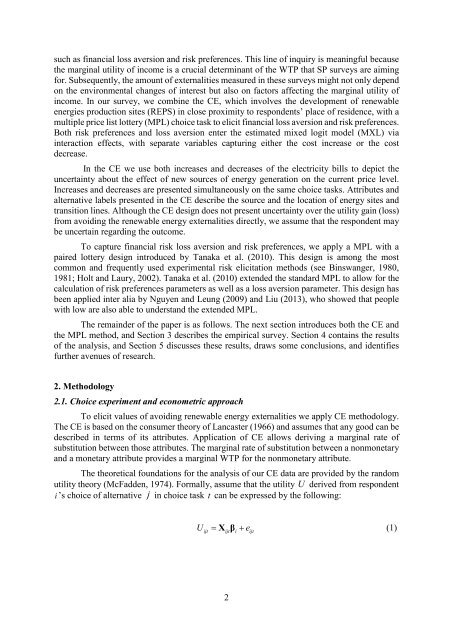Working Papers
n?u=RePEc:war:wpaper:2016-36&r=ene
n?u=RePEc:war:wpaper:2016-36&r=ene
You also want an ePaper? Increase the reach of your titles
YUMPU automatically turns print PDFs into web optimized ePapers that Google loves.
such as financial loss aversion and risk preferences. This line of inquiry is meaningful because<br />
the marginal utility of income is a crucial determinant of the WTP that SP surveys are aiming<br />
for. Subsequently, the amount of externalities measured in these surveys might not only depend<br />
on the environmental changes of interest but also on factors affecting the marginal utility of<br />
income. In our survey, we combine the CE, which involves the development of renewable<br />
energies production sites (REPS) in close proximity to respondents’ place of residence, with a<br />
multiple price list lottery (MPL) choice task to elicit financial loss aversion and risk preferences.<br />
Both risk preferences and loss aversion enter the estimated mixed logit model (MXL) via<br />
interaction effects, with separate variables capturing either the cost increase or the cost<br />
decrease.<br />
In the CE we use both increases and decreases of the electricity bills to depict the<br />
uncertainty about the effect of new sources of energy generation on the current price level.<br />
Increases and decreases are presented simultaneously on the same choice tasks. Attributes and<br />
alternative labels presented in the CE describe the source and the location of energy sites and<br />
transition lines. Although the CE design does not present uncertainty over the utility gain (loss)<br />
from avoiding the renewable energy externalities directly, we assume that the respondent may<br />
be uncertain regarding the outcome.<br />
To capture financial risk loss aversion and risk preferences, we apply a MPL with a<br />
paired lottery design introduced by Tanaka et al. (2010). This design is among the most<br />
common and frequently used experimental risk elicitation methods (see Binswanger, 1980,<br />
1981; Holt and Laury, 2002). Tanaka et al. (2010) extended the standard MPL to allow for the<br />
calculation of risk preferences parameters as well as a loss aversion parameter. This design has<br />
been applied inter alia by Nguyen and Leung (2009) and Liu (2013), who showed that people<br />
with low are also able to understand the extended MPL.<br />
The remainder of the paper is as follows. The next section introduces both the CE and<br />
the MPL method, and Section 3 describes the empirical survey. Section 4 contains the results<br />
of the analysis, and Section 5 discusses these results, draws some conclusions, and identifies<br />
further avenues of research.<br />
2. Methodology<br />
2.1. Choice experiment and econometric approach<br />
To elicit values of avoiding renewable energy externalities we apply CE methodology.<br />
The CE is based on the consumer theory of Lancaster (1966) and assumes that any good can be<br />
described in terms of its attributes. Application of CE allows deriving a marginal rate of<br />
substitution between those attributes. The marginal rate of substitution between a nonmonetary<br />
and a monetary attribute provides a marginal WTP for the nonmonetary attribute.<br />
The theoretical foundations for the analysis of our CE data are provided by the random<br />
utility theory (McFadden, 1974). Formally, assume that the utility U derived from respondent<br />
i ’s choice of alternative j in choice task t can be expressed by the following:<br />
U<br />
X β e<br />
(1)<br />
ijt ijt i ijt<br />
2


